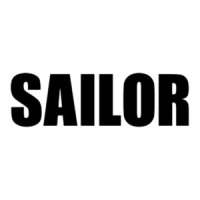9
Basic
2.8 Create emergency calls
In the category of emergency calls (1.4) you will find the
following menu:
Emergency
1.4
2 Compose Urgency
5 Compose Distress Ack
3 Compose Safety
4 Compose Relays
1 Compose Distress
Transmitting any of these calls should be done with
caution. Please make yourself familiar to the common
procedures for using these calls.
Selecting any of the call types will lead to a call establishing flow with maximum flexibility.
You should make yourself familiar with the flow sequences, but be sure you do not actually
send the message by mistake. In other words, never press the transmit verifica-
tion window if you do not actually intend to send an emergency call.
Designated distress calls are composed entering the menu (1.4.1). From this list the Nature
of Distress is selected. A fast method to reach this selection list is a short press on .
The call completion is then continued from here. If no nature of distress is selected, but
is pressed for 5 seconds, an undesignated distress is sent.
Distress calls are always transmitted by pressing the button for 5 seconds. After you
have transmitted a distress call the VHF is in distress mode (distress call is re-transmitted
once each 3½-4½ minutes). The distress mode can be exited only by reception of the
appropriate distress acknowledgement call or if you press for 5 seconds, or if you
power off the VHF. The VHF will start up in distress mode after a power failure.
2.9 DSC call log
Received and transmitted DSC messages can be found
with details in the DSC Logs (1.5). A special log contains
distress related calls. The call log system will store the
last (20) calls sorted by date and time.
DSC Logs
1.5
2 DSC Receive Log
3 DSC Transmit
4 Printing
1 DSC Distress Log
Each of the logs and each of the calls within the logs
have their own possible actions upon selection
(e.g. printing).
2.10 Entering your position into the system
Ship’s position and the time for this position are essential to the success of a possible rescue
operation. This information is automatically incorporated in a DSC distress call sent from the
VHF. Therefore it is important always to keep this information updated.
Normally a GPS is connected to the VHF, which ensures continued updating of position and
time.
If the VHF is not connected to an external GPS system, or a malfunction of the GPS
connection is detected by the VHF, the VHF will automatically prompt for manual update of
the position 1 minute after power-up and then every 4 hours. The position and time can
always be entered via the Set Position & Time selection in the Settings menu (4.1.1).
0605

